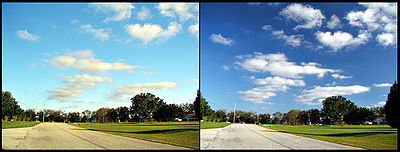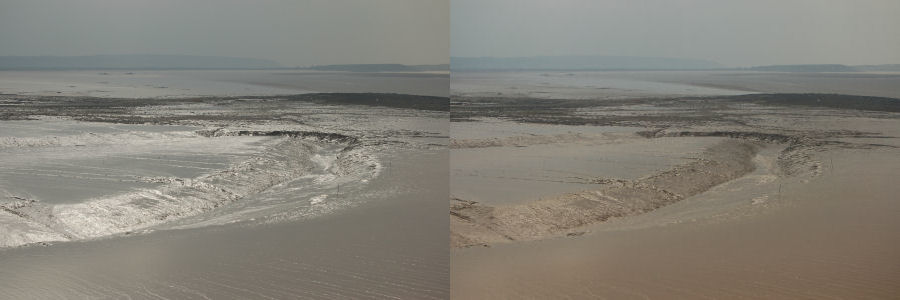
Polarizing filter (Photography)
Encyclopedia
The polarizing filter used with most modern cameras is a circular polarizer. The first stage of the polarizer is a linear filter
which filters out light that is linearly polarized
in a specific direction. The second stage, for technical reasons related to the auto sensors within the camera, then circularly polarizes
the light before it enters the camera.
The polarizing filter has two applications in both color photography
and black-and-white photography: it reduces reflections from some surfaces, and it can darken the sky.
, about 56° from the vertical (light reflected from metal is not polarized, due to the electromagnetic nature of light). A polarizer rotated to pass only light polarized in the direction perpendicular to the reflected light will absorb much of it. This absorption allows glare reflected from, for example, a body of water or a road to be much reduced. Reflections from shiny surfaces of vegetation are also reduced. Reflections from a window into a dark interior can be much reduced, allowing it to be seen through. (The same effects are available for vision by using polarizing sunglasses
.)
Some of the light coming from the sky is polarized (bees use this phenomenon for navigation). The electrons in the air molecules cause a scattering of sunlight in all directions. This explains why the sky is not dark during the day. But when looked at from the sides, the light emitted from a specific electron is totally polarized. Hence, a picture taken in a direction at 90 degrees from the sun can take advantage of this polarization. Actually, the effect is visible in a band of 15° to 30° measured from the optimal direction.
Use of a polarizing filter, in the correct direction, will filter out the polarized component of skylight, darkening the sky; the landscape below it, and clouds, will be less affected, giving a photograph with a darker and more dramatic sky, and emphasizing the clouds. Perpendicularly incident light waves tend to reduce clarity and saturation of certain colors, which increases haziness. The polarizing lens effectively absorbs these light waves, rendering outdoor scenes crisper with deeper color tones in subject matter such as blue skies, bodies of water and foliage.
The benefits of polarizing filters are largely unaffected by the move to digital photography: while software post-processing can simulate many other types of filter, a photograph does not record the degree of polarization, so the optical effects of controlling polarization at the time of exposure cannot be replicated in software.






There are two types of polarizing filters generally available, linear and circular. With the exception of how they interact with some autofocus and metering mechanisms, they have exactly the same effect photographically. The metering and auto-focus sensors in certain cameras, including virtually all auto-focus SLRs
, will not work properly with linear polarizers because the beam splitter
s used to split off the light for focusing and metering are polarization-dependent. Circular polarizers include a linear polarizer on the front, which selects one polarization of light while rejecting another, followed by a quarter-wave plate, which converts the selected polarization to circularly polarized light inside the camera, which works with all types of cameras, because mirrors and beam-splitters split circularly polarized light the same way they split unpolarized light. Linear polarizing filters can be easily distinguished from circular polarizers. In the former, the polarizing effect is the same regardless of which side of the filter the scene is viewed from. In the latter, the polarizing effect is quite marked when the scene is viewed from the male threaded side of the filter, but almost non existent when viewed from the other side.
Linear filter
Linear filters in the time domain process time-varying input signals to produce output signals, subject to the constraint of linearity.This results from systems composed solely of components classified as having a linear response....
which filters out light that is linearly polarized
Linear polarization
In electrodynamics, linear polarization or plane polarization of electromagnetic radiation is a confinement of the electric field vector or magnetic field vector to a given plane along the direction of propagation...
in a specific direction. The second stage, for technical reasons related to the auto sensors within the camera, then circularly polarizes
Circular polarization
In electrodynamics, circular polarization of an electromagnetic wave is a polarization in which the electric field of the passing wave does not change strength but only changes direction in a rotary type manner....
the light before it enters the camera.
The polarizing filter has two applications in both color photography
Color photography
Color photography is photography that uses media capable of representing colors, which are traditionally produced chemically during the photographic processing phase...
and black-and-white photography: it reduces reflections from some surfaces, and it can darken the sky.
Usage
Light reflected from a non-metallic surface becomes polarized; this effect is maximum at Brewster's angleBrewster's angle
Brewster's angle is an angle of incidence at which light with a particular polarization is perfectly transmitted through a transparent dielectric surface, with no reflection. When unpolarized light is incident at this angle, the light that is reflected from the surface is therefore perfectly...
, about 56° from the vertical (light reflected from metal is not polarized, due to the electromagnetic nature of light). A polarizer rotated to pass only light polarized in the direction perpendicular to the reflected light will absorb much of it. This absorption allows glare reflected from, for example, a body of water or a road to be much reduced. Reflections from shiny surfaces of vegetation are also reduced. Reflections from a window into a dark interior can be much reduced, allowing it to be seen through. (The same effects are available for vision by using polarizing sunglasses
Sunglasses
Sunglasses or sun glasses are a form of protective eyewear designed primarily to prevent bright sunlight and high-energy visible light from damaging or discomforting the eyes. They can sometimes also function as a visual aid, as variously termed spectacles or glasses exist, featuring lenses that...
.)
Some of the light coming from the sky is polarized (bees use this phenomenon for navigation). The electrons in the air molecules cause a scattering of sunlight in all directions. This explains why the sky is not dark during the day. But when looked at from the sides, the light emitted from a specific electron is totally polarized. Hence, a picture taken in a direction at 90 degrees from the sun can take advantage of this polarization. Actually, the effect is visible in a band of 15° to 30° measured from the optimal direction.
Use of a polarizing filter, in the correct direction, will filter out the polarized component of skylight, darkening the sky; the landscape below it, and clouds, will be less affected, giving a photograph with a darker and more dramatic sky, and emphasizing the clouds. Perpendicularly incident light waves tend to reduce clarity and saturation of certain colors, which increases haziness. The polarizing lens effectively absorbs these light waves, rendering outdoor scenes crisper with deeper color tones in subject matter such as blue skies, bodies of water and foliage.
The benefits of polarizing filters are largely unaffected by the move to digital photography: while software post-processing can simulate many other types of filter, a photograph does not record the degree of polarization, so the optical effects of controlling polarization at the time of exposure cannot be replicated in software.






| 0 degrees rotation | 30 degrees rotation | 60 degrees rotation | 90 degrees rotation |
|---|---|---|---|
There are two types of polarizing filters generally available, linear and circular. With the exception of how they interact with some autofocus and metering mechanisms, they have exactly the same effect photographically. The metering and auto-focus sensors in certain cameras, including virtually all auto-focus SLRs
Single-lens reflex camera
A single-lens reflex camera is a camera that typically uses a semi-automatic moving mirror system that permits the photographer to see exactly what will be captured by the film or digital imaging system, as opposed to pre-SLR cameras where the view through the viewfinder could be significantly...
, will not work properly with linear polarizers because the beam splitter
Beam splitter
A beam splitter is an optical device that splits a beam of light in two. It is the crucial part of most interferometers.In its most common form, a rectangle, it is made from two triangular glass prisms which are glued together at their base using Canada balsam...
s used to split off the light for focusing and metering are polarization-dependent. Circular polarizers include a linear polarizer on the front, which selects one polarization of light while rejecting another, followed by a quarter-wave plate, which converts the selected polarization to circularly polarized light inside the camera, which works with all types of cameras, because mirrors and beam-splitters split circularly polarized light the same way they split unpolarized light. Linear polarizing filters can be easily distinguished from circular polarizers. In the former, the polarizing effect is the same regardless of which side of the filter the scene is viewed from. In the latter, the polarizing effect is quite marked when the scene is viewed from the male threaded side of the filter, but almost non existent when viewed from the other side.
See also
- Circular polarizers
- PolarizerPolarizerA polarizer is an optical filter that passes light of a specific polarization and blocks waves of other polarizations. It can convert a beam of light of undefined or mixed polarization into a beam with well-defined polarization. The common types of polarizers are linear polarizers and circular...
- Polarized 3D glasses

